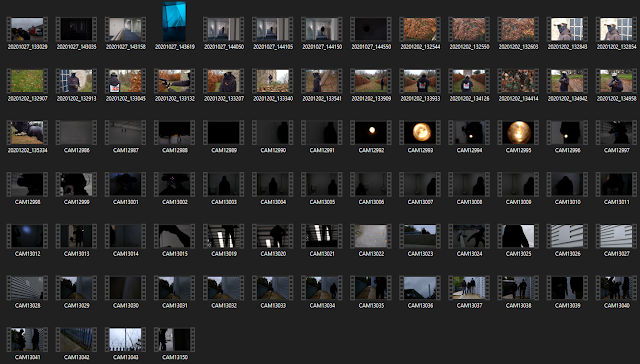We were interested in the idea of using a news broadcast as a way to give the audience an insight into the story. This news read would only suggest what is happening to motivate the audience to keep watching. We experimented with the use of a green screen to create a digital newsroom from which a news anchor reports.
Sunday, 20 December 2020
CONSTRUCTION: GREENSCREEN AND VOICE RECORDINGS
Monday, 7 December 2020
Thursday, 3 December 2020
CONSTRUCTION: SECOND FILMING SHOOT
Once we had established where we planned to film next, we were eager to begin. The filming location was a secluded area of our school's grounds that featured thick woodlands and abandoned belvedere. We felt this would be an excellent area for our project and play well into our theme of a supernatural thriller. A few days before filming with the actors, Tom Alex and I scoped out the area and I took some establishing shots of the area. These were great for adding tension as the area was shrouded in fog at the time. Unfortunately on the day, we filmed with Ben there was no fog. This was not an issue though as our project is a trailer, continuity is not required between shots. Although we did talk about how the drastic change in appears the filming location had between filming shoots could be implemented into the supernatural elements of our film.
Friday, 27 November 2020
RESEARCH: CINEMATIC STORYTELLING
Tuesday, 3 November 2020
CONSTRUCTION: LOCATION FILMING
On the 27th of October Tom and I met up with our actors to carry out our first filming shoot. As we were yet to fully establish our plot, the shoot was mostly focused on establishing and any footage we would want to use for transitions or to convey the characters are moving around the setting. Once we had all arrived we began outlining what we wanted to achieve that day, and what we planned to do with the actors. Tom was in charge of directing so I looked to him for instructions on the layout of the film and where he wanted to film and what to happen there. I was in charge of filming, it was my job to ensure that the film's story can be conveyed to the audience through camera. Using different techniques and conventions.
Monday, 2 November 2020
Sunday, 1 November 2020
Friday, 30 October 2020
Thursday, 29 October 2020
Tuesday, 27 October 2020
PLANNING: SOCIAL ISSUES AND GROUPS
Friday, 16 October 2020
PLANNING: MY TARGET AUDIENCE
For the successful release of a piece of media, a distributor must understand who is going to enjoy the film and how they are going to get them to watch the film. To first visualise the audience that would be interested in watching our project, we created questionnaires and sent them out. These questionnaires asked participants questions on what they looked for in a film and other information. This information would go on to help us build an audience profile.
Audience Questionaire
Trailer One:
Tuesday, 13 October 2020
PLANNING: INITAIL DEVELOPMENT
Mind Map
Further Brainstorming
Monday, 12 October 2020
PLANNING: LOCATION RECCE
For our location, we wanted to find a setting that would work effectively with a genre of horror/thriller. Luckily Thomas Hutchinson, the Founder of Ignite Films, had a contact in the surveying industry. This contact would have access to a list of buildings not in use that we could use. As well as this, we looked at the infamous Hollywood Lodge in Epsom. We planned to look at as many locations we could during the half-term. We had a friend who lived nearby to the lodge and asked them if they could get us some photos. For the surveying contact, they generously sent us a file containing images of the locations.
Location 1
Location 2
Hollywood Lodge
PLANNING: BACKGROUND RESEARCH
Our main inspiration to create a trailer for a Horror/Thriller film came from a YouTube channel under the name of Evan Royalty. Even Muir, the channel's own, creates short films with the production company Retro Digital. His short films are inspired/based on the SCP Foundation. A public and online forum, in which members create 'anomalies' for this made-up Foundation to have in their possession. These anomalies range from comic horrors to a harmless teddy bear. The main purpose of the SCP there is no limit on what an 'anomaly' can be. Evan has created two short films and is currently in the production of his third. For our project, we plan to recreate a similar product as Evan's films.
Evan Muir
SCP: Overlord is Evan's latest short film that is currently in production. What we all agreed that we liked in this trailer was the tense atmosphere that is created from the hard soundscape and dark colour grading. As well as this, it features the military theme that we are also wanting to create and gives us guidance on how to using this theme effectively in a trailer.Friday, 9 October 2020
RESEARCH: WHO IS THE TARGET AUDIENCE?












































